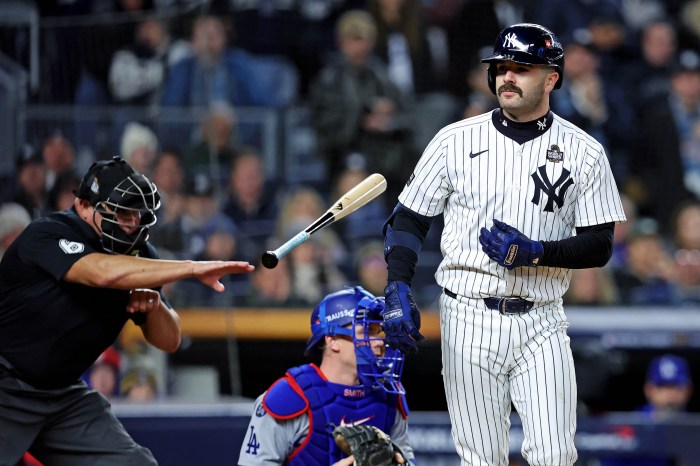A little more than two years ago, the New York Giants were 11-5 and about to play the Green Bay Packers in the opening round of the NFL playoffs.
They’ve won just eight games since, and the current G-Men are barely recognizable from that team. Gone are superstar receiver Odell Beckham Jr. Shipped out are lucrative free-agent defensive talents Olivier Vernon and Damon Harrison. A first-team, All-Pro safety was allowed to walk in free agency. Head coach Ben McAdoo quickly wore out his welcome.
All that remains, at the core, is Eli Manning. The stalwart quarterback who guided the Giants to a pair of Super Bowl championships remains atop the depth chart, with no heir apparent on the roster.
That’s about to change after this weekend’s NFL Draft, which begins Thursday. One way or another, general manager Dave Gettleman is going to get a young quarterback into the building in East Rutherford, and head coach Pat Shurmur will give him the chance to supplant the 38-year-old Manning, likely for good.
Although the Giants were bad enough in 2018 to earn the No. 6 overall pick, a series of trades highlighted by one that shipped Beckham and Vernon to the Cleveland Browns resulted in the team holding 12 selections over seven rounds. Two of them are in Round 1, and eight of them are in the top 150.
Unless presumptive No. 1 overall pick Kyler Murray somehow slips to No. 6, or the Giants move up, Gettleman can use the first pick on the best available player and fill needs anywhere on defense or along the offensive line. Then, they can select a passer at No. 17, or even trade up to get him if the stars align. If the rumor mill is to be believed, and the Arizona Cardinals do take Murray first, the Cards might send last year’s first-round QB Josh Rosen to the Giants.
Assuming that doesn’t happen and the Giants do select a quarterback at No. 17, here’s a look at the top three who might be available to them.
Dwayne Haskins
Of this group of three Haskins is the most likely to be out of reach at the Giants’ second first-round slot. Several teams, from the Oakland Raiders at No. 4 to the Washington Redskins at No. 15, could decide the Ohio State product is their QB of the future.
If he slips past Washington, which reportedly would love to add him, Haskins could give the Giants one of the best pocket passers in recent memory. He torched the Big Ten with 4,831 yards, a 70% completion rate, 50 touchdown passes and just eight interceptions. He added four rushing TDs, but Haskins is more akin to Manning than modern dual-threat quarterbacks like Murray.
At 6-3 and 231 pounds, Haskins possesses ideal size for a passer. What’s not ideal is his relative lack of experience in college. The redshirt sophomore threw only 57 passes for the Buckeyes before last year.
A downfield passer who has earned praise as a high-character individual, the Giants might see Haskins as the centerpiece of their rebuild, one who can lead by example the way Manning did for more than a decade. That is, if they can snag him first.
Drew Lock
The Missouri passer brings a wealth of FBS experience to the table. By the end of his senior season, Lock was one of just five players to attempt at least 1,500 passes over the last four years. He also fell one TD pass shy of being the fourth in that span with 100. The bulk of his stats came against the SEC, college football’s premier conference.
The red flag, from a statistical perspective, is Lock’s career 56.9% completion rate. On the bright side, his percentage rose steadily each year, from 49% as a freshman to 62.9% in 2018. To go along with that, he posted an interception rate under 2% for the first time as a senior, even as his TD passes dipped from 44 as a junior to 28 in his final year at Mizzou.
Lock is considered by some to have the best arm in this class, with a will to throw downfield. However, despite his improved completion and interception rates, there remains concern about his decision-making.
There’s a chance the 6-4, 228-pound Lock could fall to the second round, so if the Giants feel comfortable passing on QB at 17, they might see if he can be had at No. 37, or with a late first-rounder via trade.
Daniel Jones
The lone hybrid passer of this trio, Duke redshirt junior Jones averaged 11.3 rush attempts per game as a three-year starter.
Although his passing numbers with the Blue Devils were solid last season (2,674 yards, 22 TDs, 9 INTs, 60.5% completions), it was his MVP performance in the Senior Bowl that distinguished him. Past Giants picks Philip Rivers, Davis Webb and Kyle Lauletta previously earned that distinction, as did Dallas Cowboys QB Dak Prescott — mixed company, to be sure.
Jones missed two games last year after breaking his collarbone, and one of the major knocks on him is the time it takes him to get rid of the ball. It’s too soon to say that injuries will pile up, but the Giants’ offensive line isn’t likely to give him any more time this year than he had at Duke.
Giants overall picks
Round 1: Nos. 6 and 17
Round 2: No. 37
Round 3: No. 95
Round 4: Nos. 108 and 132
Round 5: Nos. 142, 143 and 171
Round 6: No. 180
Round 7: Nos. 232 and 245




































